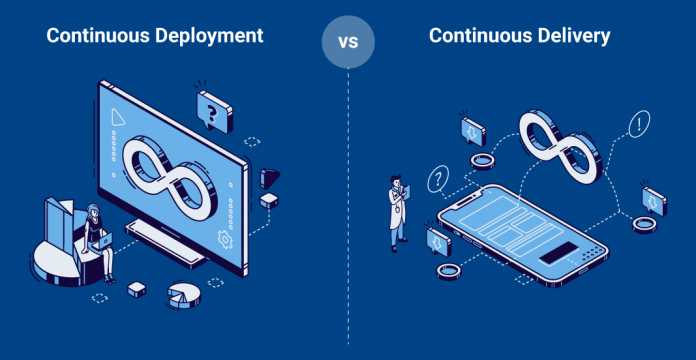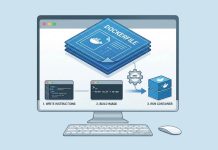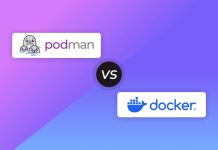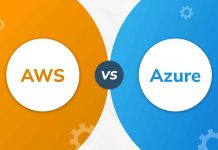
Providing software updates to users immediately is crucial in today’s technologically evolved business landscape. You know from your mobile phones and computers that software updates for applications are an everyday experience. We exist in the “internet time.” The aim to be quick and active with regards to meeting users’ requirements can be a great achievement for a company, but the failure to do so could mean the end.
To survive and to stay relevant, businesses must be able to accommodate changes both quickly and regularly. This is how you get thoughts out fast and bring business value to clients. And, being able to do this needs continuous activity.
Managing Continuous Delivery and Continuous Deployment in the Solution Delivery Pipeline means your team is ready and can deliver updates to users in a sensitive manner; these 2 phases in the pipeline are fundamental to the overall goal of fast, active deployments. However, sometimes there is uncertainty about how they differ from each other.
In this study, we will clarify the difference between Continuous Delivery and Continuous Deployment and explain how each fits into an Agile scenario.
What is the requirement for Digital Pipelines?
Continuous Integration (CI) and Continuous Delivery (CD) embrace a culture, set of working systems, and set of exercises that allow application development companies to deliver code modifications more frequently and probably.
CI/CD is one of the most beneficial methods for DevOps teams to perform. It is also an active methodology, as it allows software development teams to concentrate on meeting business demands, code quality, and security because deployment actions are programmed.
CI/CD Defined
Continuous integration is a coding theory and set of exercises that drive improvement teams to perform small modifications and check-in code to version control repositories regularly. Because most common applications need developing code in different stages and tools, the unit requires a device to integrate and verify its changes.
The technical purpose of CI is to build a consistent and automatic way to create, package, and test certificates. With flexibility in the integration process in position, teams are more inclined to perform code changes more often, which points to better collaboration and software quality.
Continuous delivery starts where continuous integration ends. CD automates the delivery of applications to elected support environments. Most teams operate with various situations other than the production, such as developing and testing settings, and CD ensures there is an automatic way to push code modifications to them.
CI/CD tools help the environment-specific parameters that need to be packaged with each delivery. CI/CD automation then offers any necessary service appeals to web servers, databases, and other services that may require to be restarted or follow other methods when applications are deployed.
Introduction to Continuous Delivery
Continuous Delivery is the force to get variations of all types—including innovations, configuration settings, defect fixes, and experiments—into production, or the hands of users, safely and swiftly in a sustainable way.
The purpose is to make deployments—whether of a large-scale shared system, a combined production environment, an installed system, or an app—predictable, everyday affairs that can be performed on request.
This is accomplished by securing code that is continuously in a deployable state, even in the appearance of units of thousands of developers making changes daily. We thus eliminate the alliance, trial and hardening conditions that traditionally followed “dev complete”, as well as code freezes.
There are five beliefs at the heart of Continuous Delivery:
- Develop quality
- Work in small groups
- Computers execute monotonous tasks; people solve problems
- Relentlessly seek continuous improvement
- Everyone is qualified
Continuous Delivery Case Study: LinkedIn
LinkedIn’s newly-adopted software development methodology is recognized as “continuous delivery.”
LinkedIn’s former system of software development was traditional and included software “branches” forked off from the center and increased in parallel over weeks or days. A developer would consume a big group of code corresponding to the particular point and then request for this feature branch to be mixed into the trunk. Once mixed into a trunk, the feature would again need to be tested to ensure it did not violate any of the other new code checked into a trunk at the same time. Bugs and entirely occurred software are obvious under this so-called “feature branch” method, since typically any big batches of code, each addressed in retirement by a separate team, are blended into a trunk at once. To evade such meltdowns, managers led to tightly limit the amount and scope of new stories smashed together each month, reducing down a company’s growth cycle.
The effect has resulted in LinkedIn now giving quick sets of new features for recruiters, including an intelligent “somebody you should select” suggestion box. And it can be observed in all the different outcomes LinkedIn has struck out over the past time, including revised company sheets, improved intelligence, a redesigned homepage, remarks and likes on news pages, iPad and Windows apps, revamped profile pages, a job listings app, and blogging features. Just this week, Linkedin spread out a feature cribbed from Facebook that lets users hotlink their friends in status updates.
The key distinctions between Continuous Deployment & Continuous Delivery
| Definition | Benefits | For Whom? | Effort | |
| Continuous Deployment | A software engineering work in which code modifications are fixed to be published to production. | – Guarantees frequent statements.– Guarantees releases are created in smaller pieces.– Allows immediate replies to errors.– Forms releases are more durable, reliable, and controllable. | Organizations that require to stage new innovations and announcements on a frequent program | – Orders were practicing continuous delivery solutions to automate deployment.– Test automation is leveraged to recognize whether the software meets exit standards or not. |
| Continuous Delivery | A software engineering practice that guarantees code changes are continuously released into the production environment. | – Guarantees each deployment step is performed immediately and inevitably.– Reduce manual actions and automate the entire method.– Grants teams to build a completely automated CI/CD pipeline. | Organizations that release new features on a daily and hourly basis. Ensure cross-department coordination (development, support, marketing, business, etc.) is maintained. | – Same as continuous Delivery with an added emphasis in testing once in production.– Ability to automate rollback of production features should also be considered. |
Increase Customer Experience with DevOps
The industry of DevOps has grown tremendously over the past few years, and with its increasing popularity, the growth shows no signs of stopping. You can implement this methodology to provide your customers with a better experience by training individuals and enterprise teams in DevOps Certification Courses.
At Invensis Learning, we provide a host of industry-recognized DevOps certifications which are:
- DevOps Professional Certification Course














